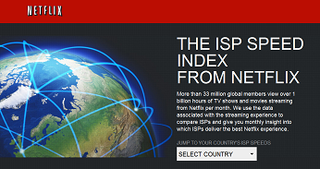Netflix Nails Up Dedicated Site for ISP Rankings

Netflix is wielding a new tool to try to persuade Internet service providers to join its content-delivery network program, with the launch Monday of a dedicated “ISP Speed Index” website.
The website, at http://ISPSpeedIndex.Netflix.com, replaces Netflix’s previous monthly blog posts with the same data ranking broadband providers based on the average bandwidth they deliver to the company’s streaming members.
The new site also provides speed info for countries outside the U.S., launching initially with Mexico, Ireland, U.K., Norway, Sweden, Denmark and Finland.
Netflix’s goal with the ISP rankings appears to be recruiting more providers for its Open Connect CDN. Netflix saves money on third-party CDN transit fees by co-locating caching servers that store copies of the most-frequently accessed content at ISPs' data centers.
ISPs can participate in the program at no cost, according to Netflix. As an added incentive to encourage providers to participate in the private CDN, the company provides access to select titles in higher-quality “Super HD” format and 3D content to subscribers of Open Connect partners.
Time Warner Cable has complained that Netflix is unfairly holding back content in trying to secure “preferential treatment” from ISPs with the Open Connect initiative.
According to Netflix, ISP data for February indicates Google Fiber -- which is an Open Connect partner -- delivers the highest connection speeds (3.35Mbps) anywhere in the world.
Multichannel Newsletter
The smarter way to stay on top of the multichannel video marketplace. Sign up below.
Netflix members in Finland receive on average the highest bit rates, while members in Mexico have the slowest connections on average.
In the U.S., cable operators and fiber-to-the-home providers rank higher than DSL services.
For February, Cablevision Systems (also an Open Connect partner) delivered the second-fastest connection speed at 2.35 Mbps; the MSO's average includes sessions accessed through its Optimum Wi-Fi network of access points in the New York region. ISPs delivering at least 2 Mbps were Suddenlink Communications, Cox Communications, Verizon FiOS, Charter Communications, Comcast, Mediacom Communications, Time Warner Cable and Bright House Networks.
U.S. ISPs under the 2-Meg mark included AT&T U-verse, CenturyLink, Windstream, Frontier, AT&T legacy DSL, Verizon DSL and Clearwire.
As of the end of 2012, Netflix had 27.15 million U.S. streaming users, with more than 33 million total worldwide.
Netflix notes that the average performance it measures is less than the peak performance available on any given ISP, due to factors including the variety of encoding algorithms Netflix uses as well as the variety of devices members use and home network conditions.










